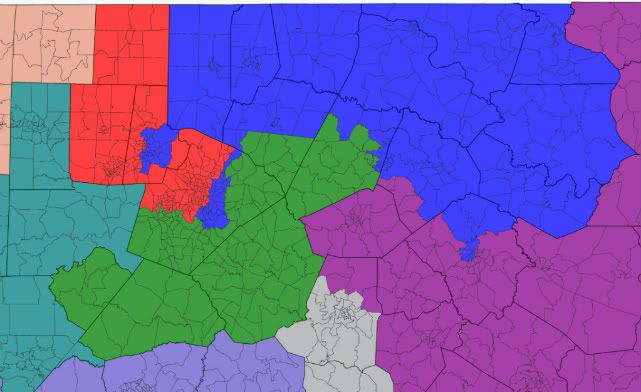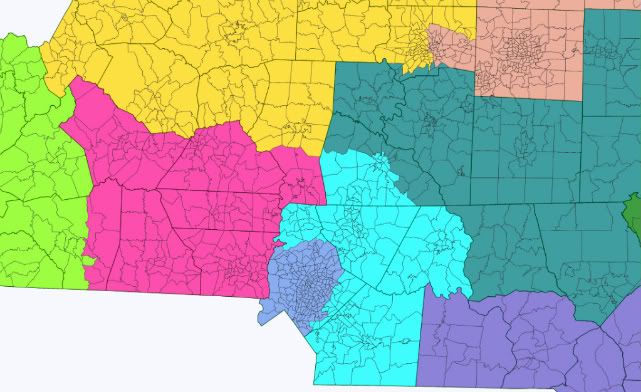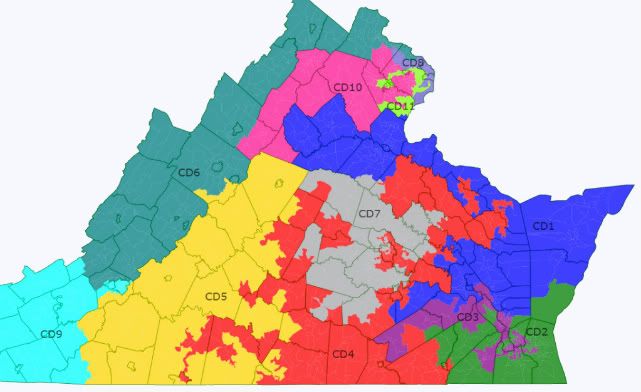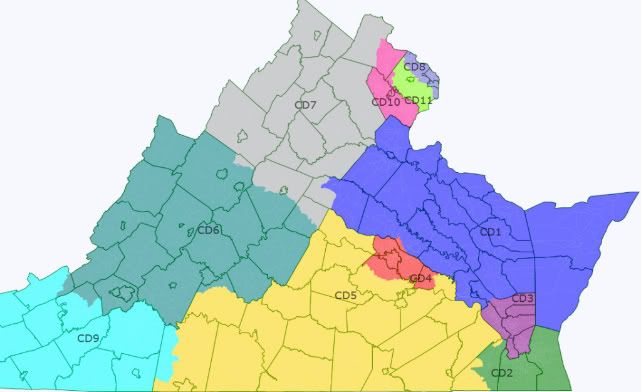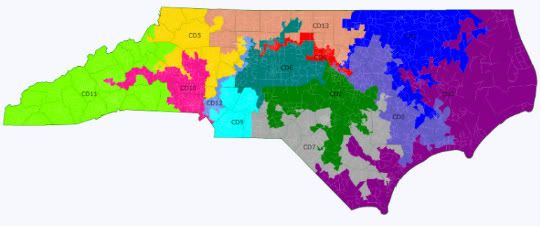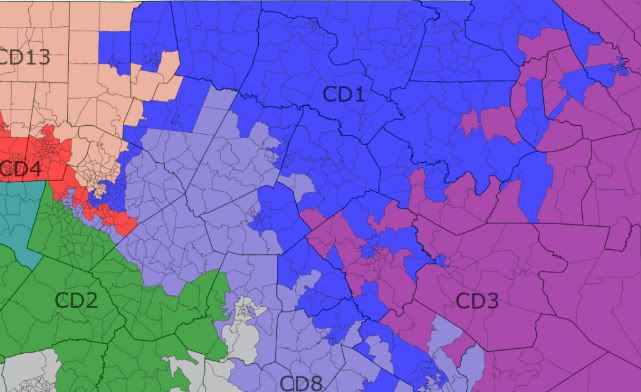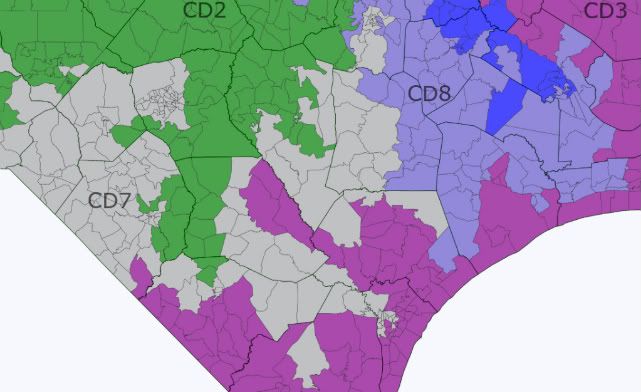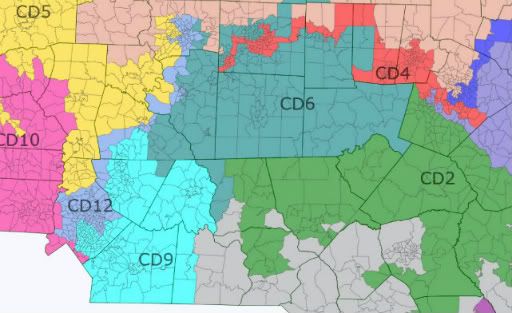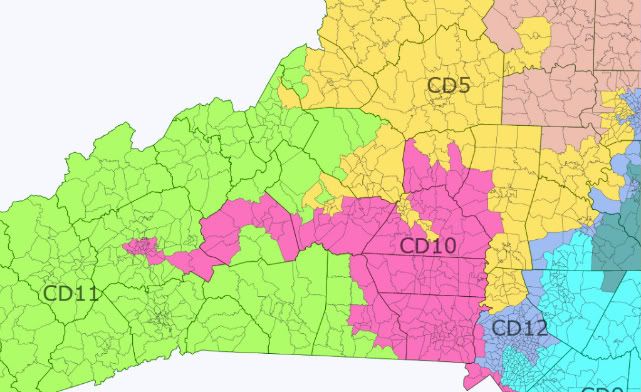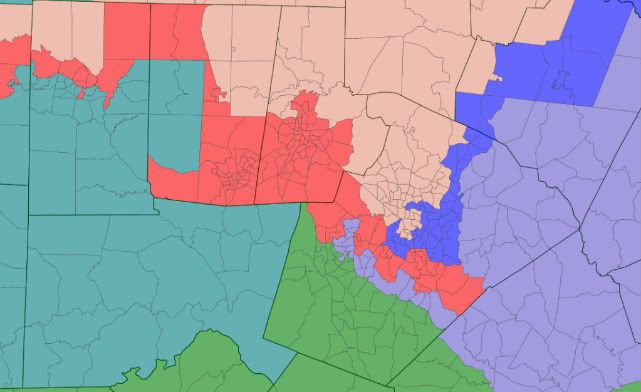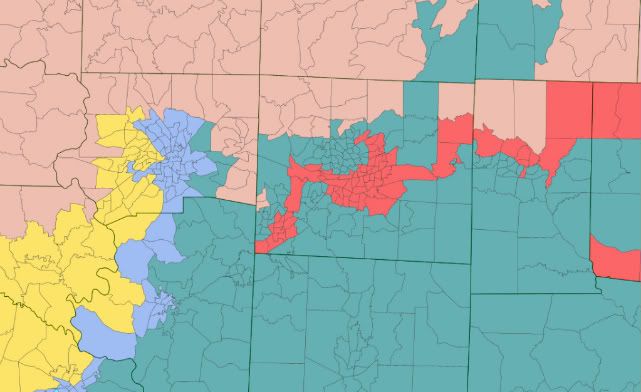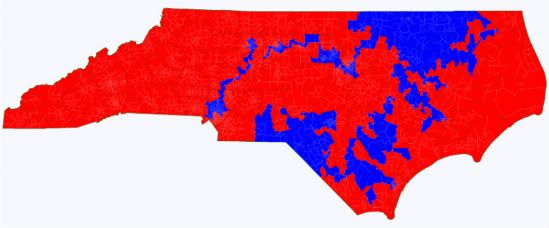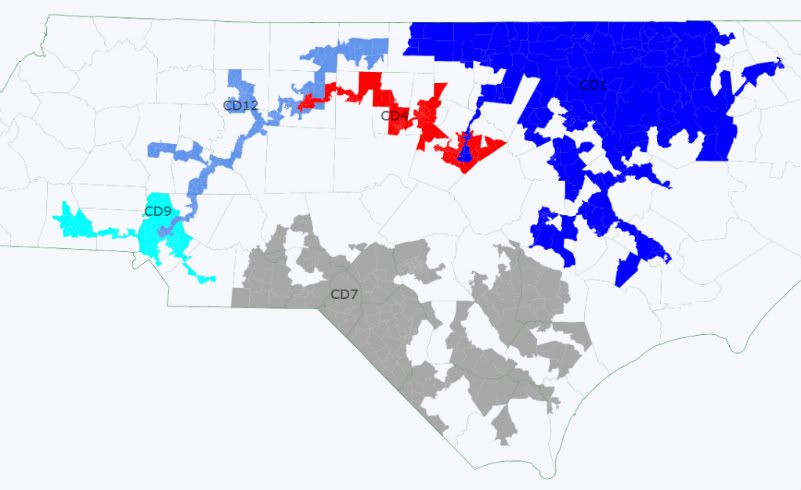The following map was drawn to resemble the potential product of a possible non-partisan independent redistricting commission which has been proposed but unlikely to be implemented in North Carolina. The goals I had for drawing the districts consisted of geographic compactness, relevant communities of interest without regard to incumbency, and maintaining a VRA-protected black majority district in northern/eastern NC. Only 13 counties were split, 6 of which were done to draw a VRA district, and I tried to avoid splitting towns where possible.
NC-01 (Blue) (Open)
70.2% Obama 50.0% Black, 38.8% White
The first district is VRA protected and hence was my starting point since it needed to gain around 100,000 people from its current configuration. The major change is that the 1st now includes the heavily black portions of Durham and Raleigh and recedes from the coast to avoid splitting counties. The black voting age population could likely be increased a couple percentage points with precinct level data since the Wake county voting districts are quite large. This was also the only district which required double-crossing counties, but it is still far more compact than the current version.
Politically, this district is still very heavily Democratic, and although it no longer contains G.K. Butterfield’s home of Wilson he would probably run here.
Safe Democratic
NC-02 (Green) Renee Ellmers (R-Dunn)
55.2% McCain 70.9% White
The second district becomes much more compact by shredding its arms into Fayetteville and Sampson County and settling around suburban Wake County. Ellmers would probably like this district since it’s much more Republican, however she is representing a large amount of new territory. Suburban Wake County was also home to a large amount of the region’s explosive growth as people moved into North Carolina, and the district will likely experience substantial change over 10 years. The same disclaimer for NC-01 goes here though: the Wake County voting districts contain very large amounts of people so precinct data would make the 2nd Whiter since it could trade black population to the 1st.
Safe Republican
NC-03 (Purple) Walter Jones (R-Farmville) / G.K. Butterfield (D-Wilson)
54.1% McCain 68.6% White, 24.6% Black
As the second part of the map I drew, the 3rd is essentially a complement to the 1st by absorbing its tendrils towards the coast. The most major changes to the 3rd are that it no longer includes Onslow County and Camp Lejeune while including New Bern and Wilson since it is intended to be a district for the northeastern coast and Outer Banks. While both Jones and Butterfield live here, Jones would be heavily favored and fairly lucky that he didn’t get drawn into NC-01. While moderate-to-conservative white Democrats have historically done well in eastern NC, the Democratic primary would contain a large minority voting base which could increase the chances of nominating a minority candidate or someone viewed as too liberal. Furthermore, Jones has a fair amount of crossover support, likely due to his father’s long tenure as a Democratic rep and his own somewhat heterodox positions. Lastly, state Dems suffered heavy losses here in 2010, which could signal the rise of more party polarization among whites.
Safe Republican
NC-04 (Red) David Price (D-Chapel Hill) / Brad Miller (D-Raleigh)
61.1% Obama 70.4% White, 14.2% Black
The 4th district trades large amounts of Wake County among neighboring districts so that it contains the rest of Raleigh and Durham, in addition to Chapel Hill and most of Cary. Like the 2nd, this district contains some of the highest-growth parts of the state, but unlike the second would have a very large proportion of white liberals. A Democrat is virtually guaranteed to win here, but since both Price and Miller have a large part of their base in the district it would be interesting to see who would emerge from a primary, although it is possible that Price would retire instead.
Safe Democratic
NC-05 (Yellow) Virginia Foxx (R-Banner Elk)
59.1% McCain 84.1% White
The 5th is largely unchanged from the current district but on the whole moves slightly westward to accommodate the changes to the 10th. It still contains about half of Winston-Salem which only makes up a fifth of the total district. Unfortunately, this means that Virginia Foxx could and would win here.
Safe Republican
NC-06 (Teal) Larry Kissell (D-Biscoe)
60.6% McCain 79.2% White
The 6th was drawn to constitute represent small town/rural central NC and therefore loses its large portions of Guilford County. The largest city in the new 6th is now Burlington with 50,000 people and the next two largest cities are around half that size. While Kissell is drawn into the district, it’s much more likely that he would run in the neighboring 8th if he ran at all and that Howard Coble would run here since it contains a decent portion of his current district. In the event that Coble retired, a Republican would have little trouble holding this seat.
Safe Republican
NC-07 (Gray) (Open)
54.7% McCain 72.4% White, 17.6% Black
The new 7th was drawn to include the southernmost portion of the NC coast and as a result contains Wilmington, Jacksonville, and then Goldsboro at the northern end since I thought it more appropriately belonged to eastern NC than to a Raleigh metro area district. Mike McIntyre might consider running here since he already represents Wilmington and over half the total district. Like the 3rd, this district contains areas which have been friendly to conservative white Democrats, so McIntyre wouldn’t be completely screwed, but would still be facing a very difficult challenge.
Likely Republican
NC-08 (Slate) Mike McIntyre (D-Lumberton)
55.8% Obama 48.2% White, 32.3% Black, 8.8% Native, 7.3% Hispanic
The 8th district changes significantly by losing Charlotte and becoming anchored around Fayetteville and Robeson County, which contains McIntyre’s home of Lumberton. This district forms a better community of interest for inland southeastern NC and also has a significant minority presence due to a large black and Native American population. Mike McIntyre wouldn’t stand a chance here though since he’s far too conservative for a 56% Obama district and would likely face a challenge from a minority/liberal Democrat. Larry Kissell on the other hand might be able to win here since it contains a majority of the current 8th and Kissell probably has more credibility to move to the left than McIntyre would. Regardless of who wins the eventual primary barring a Coakley repeat, Democrats would be heavily favored.
Safe Democratic
NC-09 (Cyan) (Open)
59.6% McCain 77.5% White
The 9th changes significantly by moving out of almost all of Charlotte proper and instead forms around the suburbs and exurbs to the east and north of the city. As drawn, this district had the most growth of any over the past 10 years and will probably continue to see significant growth as the Charlotte metro area grows. Sue Myrick technically lives in Charlotte, but she would probably have no trouble running and winning here despite half the territory being new.
Safe Republican
NC-10 (Magenta) Patrick McHenry (R-Cherryville)
62.3% McCain 81.9% White
The biggest change to the 10th is that it now includes all of Gastonia and Appalachian territory to the 5th and 11th. The core of the district is a bit more southwestern Piedmont NC now than Appalachian, but still contains elements of both. Like with Virginia Foxx, McHenry is essentially still representing his own seat due to geographic constraints.
Safe Republican
NC-11 (Chartreuse) Heath Shuler (D-Waynesville)
52.2% McCain 88.9% White
The 11th undergoes the least change of all the districts since it is tucked into a corner. The only changes include the addition of Mitchell County and more of Rutherford County. As a result, this district stays fairly swingy, but Shuler should have a strong advantage due to his incumbency and conservatism.
Likely D with Shuler
Tossup/Tilt R if Open
NC-12 (Steel Blue) Mel Watt (D-Charlotte) / Sue Myrick (R-Charlotte)
66.4% Obama 48.1% White, 33.5% Black, 11.7% Hispanic
Nearly everyone who’s learned of gerrymandering in civics class in the last 20 years knows of the infamous NC-12 (though usually in the context of it helping Democrats… yeah, I’m not sure how that still happens either). Well fear no more, the arm up I-85 is gone! The 12th is not a legally mandated VRA district and thus can avoid worrying about retrogression. The district now contains almost all of Charlotte proper in addition to the western edge of Mecklenburg County. It’s still majority minority, but plurality white. However, this district grew significantly from 2000-2010 and went from 55.9% to 44.2% white by total population. Anyway, Mel Watt should be pretty well situated to win here if he can avoid a primary challenge; only 1/3rd of the district is currently in the 12th, but it consists mostly of black Democrats who form Watt’s base.
Safe Democratic
NC-13 (Salmon) Howard Coble (R-Summerfield)
57.6% Obama 58.3% White, 31.0% Black, 6.5% Hispanic
The 13th is essentially a different district, and here it gives the Triad its own district since the 12th is now removed. Since I wanted to make the 5th and 6th as compact as I could without having them surround the 13th, I ended up splitting Winston-Salem and giving the more minority heavy parts to the 13th. An alternative drawing places all of Winston, High Point, and Greensboro in the 13th and has the 5th and 6th readjust to take in Rockingham and Caswell counties plus rural/suburban Guilford, but I felt that this was too much of a gerrymander and it also splits another county. In any event, Coble stands no chance here and probably calls it quits, but since he has supposedly forsworn his House pension and retirement benefits, he might run in the 6th instead. Democrats should easily hold this version of the 13th.
Safe Democratic
Alternate NC-5/6/13:
NC-05 62.3% McCain
NC-06 60.2% McCain
NC-13 60.3% Obama
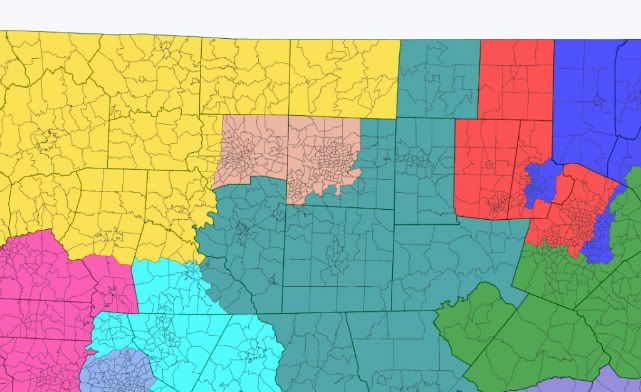
The likely result: 5D – 7R – 1(Shuler)
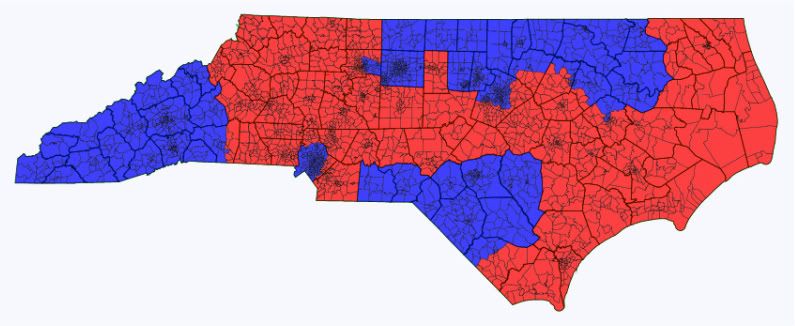
Summary:
Overall the district lines have become much cleaner, especially in eastern NC. All but 3 of the seats are practically safe for the incumbent party, and the likely partisan change in the near-term results in Republicans picking up the 7th district. From a compactness standpoint, the districts correlate fairly clearly to distinct communities of interest, especially in Eastern NC, and Charlotte and the Triad get their ‘own’ seats. Again, the black % of the 1st can be increased with a more precise mapping tool since the Wake County voting districts are huge.
What I really liked about this map was the division of southeastern and coastal NC since they constitute pretty coherent communities of interest. Additionally, both the 7th and 3rd contain areas where moderate to conservative Democrats performed fairly well, although Dems lost several statehouse seats there in 2008, but the partisan numbers for Obama/McCain are somewhat misleading since he significantly underperformed Kay Hagan in 2008. Therefore, Dems would have a decent chance to win the 7th with a strong moderate candidate in the right environment, but barring a McIntyre upset in 2012, and thus continued incumbency, would still be the definite underdogs. Regardless, the coastal area is likely a region where Democrats are losing their influence due to increasing ideological and race-based voting polarization.
Lastly, this map goes to show how even an independent or non-partisan map still has its obvious downside since it’s very easy to pack in Democrats in urban areas, and is among other reasons why I think it’s preferable to have some mix of proportional representation. An independent commission wouldn’t pass the General Assembly either since Republicans now have full control of the process, but it is nonetheless interesting to create a theoretically commission-drawn map.
UPDATE:
Per suggestions by user displacedyankdem I redrew the map to feature a rural NC-01 that doesn’t include any of Raleigh or Durham… and it ends up being pretty ridiculous, which leads me to think that it would have to contain either Durham or Raleigh. But here it is with two different configurations for Fayetteville:
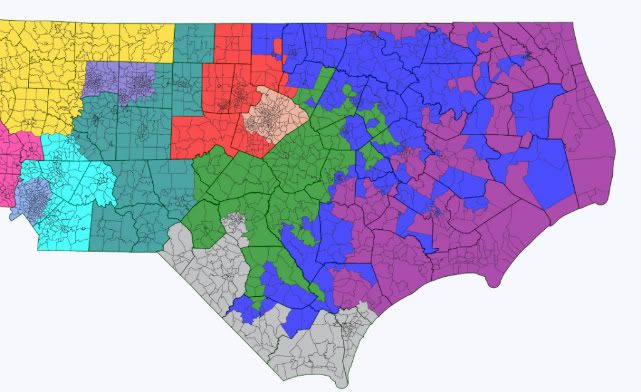
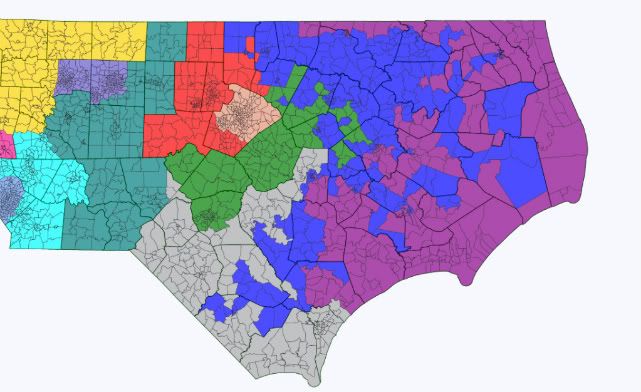
In both versions the 4th is now a Chapel Hill, Durham, Chatham County/Southern Wake County district, while the 13th is Raleigh and Cary. The Triad is now the 8th due to that district being eliminated. The 1st also meanders down the entire eastern interior of the state to find black voters, and it’s still only 50% VAP black. The 3rd is now the entire coast north of Wilmington. For these districts, the major change is that the 3rd becomes significantly whiter and more Republican while the Dem friendly district based in the southeast moves to form a third Dem district further north.
The variation between these two maps comes from Fayetteville; I had wanted to draw the 7th as a New Hanover, Robeson, and Cumberland County based district, but Fayetteville had too much population for that so in the first version it’s split while in the second it’s all given to the 2nd district. The split version makes the 7th 51.7% Obama and the 2nd 58.8% McCain, while the second version the 7th is 53.7% McCain and the 2nd is 52.1% McCain. Mike McIntyre would probably be all right in the version where his district contains Fayetteville, but would likely have a tough time in the other version.
Anyway, this all goes to show how difficult it is to draw a VRA district without including one of the major cities since North Carolina’s black population is so diffuse.

